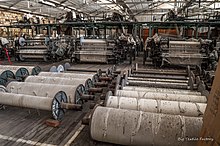| Byssinosis | |
|---|---|
| Other names | Brown lung disease, Monday fever |
 | |
| A mill where fibrous material, such as cotton, is processed from machinery. | |
| Specialty | Pulmonology |
Byssinosis[n 1] is an occupational lung disease caused by inhalation of cotton or jute dust in inadequately ventilated working environments and can develop over time with repeated exposure.[2][3] Byssinosis commonly occurs in textile workers who are employed in yarn and fabric manufacture industries. It is now thought that the cotton dust directly causes the disease and some believe that the causative agents are endotoxins that come from the cell walls of gram-negative bacteria that grow on the cotton.[4] Although bacterial endotoxin is a likely cause, the absence of similar symptoms in workers in other industries exposed to endotoxins makes this uncertain.[5] Current smokers are also at risk for developing byssinosis or having complications relating to byssinosis.[4]
Of the 81 byssinosis-related fatalities reported in the United States between 1990 and 1999, 48% included an occupation in the yarn, thread, and fabric industry on their death certificate.[6] This disease often occurred in the times of the Industrial Revolution. Most commonly young girls working in mills or other textile factories would be affected by this disease. In the United States, from 1996 to 2005, North Carolina accounted for about 37% of all deaths caused by byssinosis, with 31, followed by South Carolina (8) and Georgia (7).[7]
There is a lack of information regarding the prevalence and impact of byssinosis in low and middle income countries (LMIC) despite the fact that of the 25 million tons of cotton produced worldwide, about two thirds of this production comes from LMICs like India, Pakistan, and China.[3] Many textile mills and fiber producing factories located in LMICs have high rates of chronic respiratory disease caused by byssinosis.[3]
The term "brown lung" is a misnomer, as the lungs of affected individuals are not brown.[8] Byssinosis is also referred to as cotton worker's lung, mill fever, brown lung disease, and Monday fever.[4]
- ^ βύσσινον, βύσσος. Liddell, Henry George; Scott, Robert; A Greek–English Lexicon at the Perseus Project.
- ^ Hollander, AG (December 1953). "Byssinosis". Chest. 24 (6). American College of Chest Physicians: 674–678. doi:10.1378/chest.24.6.674. PMID 13107566.[dead link]
- ^ a b c Nafees, Asaad Ahmed; Matteis, Sara De; Burney, Peter; Cullinan, Paul (2022-01-24). "Contemporary Prevalence of Byssinosis in Low- and Middle-Income Countries: A Systematic Review". Asia-Pacific Journal of Public Health. 34 (5): 483–492. doi:10.1177/10105395211073051. hdl:10044/1/96110. ISSN 1010-5395. PMID 35073782. S2CID 246277619. Archived from the original on 2022-02-10. Retrieved 2022-02-10.
- ^ a b c Patel, Pujan H.; Yarrarapu, Siva Naga S.; Anjum, Fatima (2022), "Byssinosis", StatPearls, Treasure Island (FL): StatPearls Publishing, PMID 30137833, archived from the original on 2022-08-04, retrieved 2022-02-10
- ^ Newman, Lee S. (June 2008). "Byssinosis". Merck Manuals: online medical dictionary. Merck & Co. Archived from the original on 2010-09-08. Retrieved 2009-06-15.
- ^ "Section 4. Byssinosis and Related Exposures". The Work-Related Lung Disease Surveillance Report, 2002 (Report). National Institute for Occupational Safety and Health. 2003. pp. 87–106. doi:10.26616/NIOSHPUB2003111.
- ^ "Byssinosis: Number of deaths by state, U.S. residents age 15 and over, 1996-2005". National Institute for Occupational Safety and Health. March 2009. Archived from the original on 2013-02-20. Retrieved 2013-02-14.
- ^ Barry S. Levy; David H. Wegman; Sherry L. Baron; Rosemary K. Sokas (2011). Occupational and environmental health recognizing and preventing disease and injury (6th ed.). New York: Oxford University Press. p. 416. ISBN 9780199750061.
Cite error: There are <ref group=n> tags on this page, but the references will not show without a {{reflist|group=n}} template (see the help page).